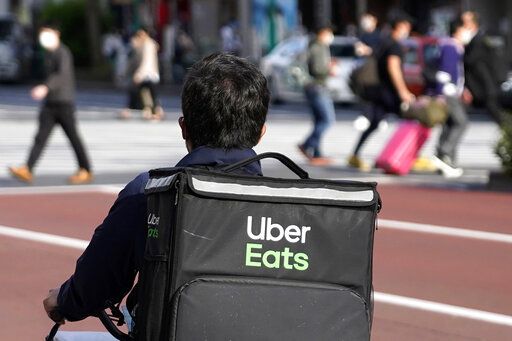Uber’s recovery accelerates as more people seek rides again
FILE – In this April 28, 2021, file photo, an Uber Eats delivery person rides a bicycle through the Shinjuku district in Tokyo, Japan. Uber’s ride-hailing service is regaining most of the momentum that it lost during the pandemic. At the same time, its delivery service is still growing at a torrid pace, indicating that some homebound habits may be here to stay, even though people are going out again. (AP Photo/Shuji Kajiyama, File)
SAN RAMON, Calif. (AP) — Uber’s ride-hailing service is regaining most of the momentum that it lost during the pandemic.
At the same time, its delivery service is still growing at a torrid pace, indicating that some homebound habits may be here to stay, even though people are going out again.
Those two trends produced Uber’s best quarterly report since the pandemic clobbered the San Francisco company 17 months ago.
The results announced Wednesday for the April-June period included a rare profit. But that stemmed from a one-time gain of $1.4 billion to recognize recent increases in the values of Uber’s stakes in China’s leading ride-hailing service, Didi, and a self-driving car division that it recently handed off to Silicon Valley startup, Aurora.
Those accounting adjustments eclipsed Uber’s ongoing losses in its business, enabling the company to post a second-quarter profit of $1.14 billion, or 58 cents share, reversing a loss of $1.78 billion suffered in the same three-month period of 2020, during the early throes of the pandemic.
Revenue for the quarter totaled $3.93 billion, more than doubling from the dismal conditions at the same time last year when most people were still stuck at home and not looking for rides to go anywhere. The revenue figure exceeded the estimate of $3.76 billion among analysts surveyed by FactSet Research.
In an even more telling sign of progress, Uber provided 1.51 billion rides during the quarter — an 105% increase from the same time last year. Despite that big jump, the total rides for the period were still roughly 10% below the number given at the same time two years ago, long before the pandemic upended the economy.
The company’s ride-hailing revenue also more than doubled from last year to $1.62 billion. Besides giving more rides than last year, Uber’s prices also have been rising. That’s partly because the company finally is trying to turn a profit, but also because it’s paying drivers more as it tries to lure more of them back behind the wheel and responds to increasing pressure from governments around the world to boost their incomes.
As it has been doing in recent quarters, the service that Uber built up to deliver take-out food and groceries is bringing in even more money. The company’s delivery revenue totaled nearly $2 billion, more than doubling from a year ago.
Uber CEO Dara Khosrowshahi predicted the progress would continue during the final half of this year, as more people look more rides and more drivers are willing to provide them or make deliveries. In the U.S. alone, Khosrowshahi said the number of ride-hailing drivers and delivery couriers has increased by about 420,000 since February.
In a sign of confidence, Khosrowshahi reiterated a previous promise that Uber will be profitable on an operating basis during the final three months of the year under an unorthodox measure called “adjusted earnings before interest, taxes, depreciation and amortization.” Under that yardstick that is closely watched by some investors, Uber lost $509 million during the most recent quarter, down from a loss of $837 million at the same time last year.
Despite the generally upbeat earnings report, shares of Uber Technologies Inc. fell about 6% in after-hours trading.
Copyright 2021 The Associated Press. All rights reserved.


